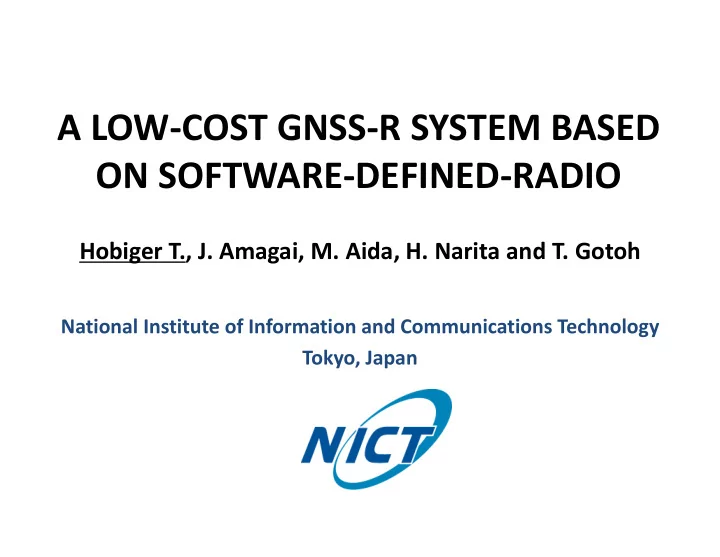

A LOW ‐ COST GNSS ‐ R SYSTEM BASED ON SOFTWARE ‐ DEFINED ‐ RADIO Hobiger T., J. Amagai, M. Aida, H. Narita and T. Gotoh National Institute of Information and Communications Technology Tokyo, Japan
GNSS Reflectometry (GNSS ‐ R) H Att = RCHP–LHCP [dB] Fresnel zone
Antenna (off ‐ the ‐ shelf components) LHCP RHCP L1 antennas, 3.5’’ diameter 2 m
Deployment NICT HQ / Tokyo
(GTX580) 2 GPUs USRP2 Data flow
Software receiver • Three modules ① Sampler: gets RHCP and LHCP data (6.25 Msps, complex I/Q) and puts data into circular buffer ② GNSS receiver: tracks all visible PRNs and computes LO offset of sampler ③ GNSS ‐ R module: computes delay ‐ doppler ‐ maps (DDM) and writes them to binary files • Module and run on the GPU and thus don’t conflict with the real ‐ time data streaming of module .
Sampler module
URSP local offset determination • Clocks of the two USRPs are synchronized via MIMO cable • BUT: internal clock of USRP (master) is free ‐ running (only TCXO) • Leads to unknown, quite large and varying LO offset needs to be monitored before data can be processed • Additionally, navigation message modulated on GPS carrier leads to ± 180 degree phase jumps if the bit status changes detection of navigation message bits necessary
URSP local offset determination(ctd.) data Parallel software GPS receiver DLL, PLL and navigation bits (see Hobiger et al., 2010) output CPU GPU Measured Doppler shift Computed Doppler shift Signal amplitude
GPU GNSS ‐ R module (core) CPU
Sample output Sep. 12 th , 2011 13:30:38 UTC, GPS PRN 02
Generation of Delay ‐ Doppler maps • Coherent integration over several milliseconds allows to derive delay and Doppler information (so called Delay ‐ Doppler map (DDM)) • DDMs can be used to deduce geophysical parameters (e.g. sea surface roughness, winds, etc.) by comparison with theoretical models
Delay ‐ Doppler map results (RHCP, 2.048 sec coh. int.) PRN03@60.25deg Delay [lag] Doppler shift [Hz]
Delay ‐ Doppler map results (LHCP, 2.048 sec coh. int.) PRN03@60.25deg Delay [lag] Doppler shift [Hz]
Long ‐ term experiment (38 d) from Aug. 17, 2011 All visible GPS satellites in RHCP and LHCP above 45 degrees elevation were tracked
Example: 24h signal attenuation map (RHCP – LHCP)
Daily maps (animated)
Time ‐ series extraction Reflection strength correlates with rainfall rate system is capable to remotely monitor soil moisture changes
Summary and outlook • We developed and deployed a low ‐ cost GNSS ‐ R system based on software radio by making use of GPUs • The system has been proven to be real ‐ time operational • First results confirm system concept • We could already detect geophysical signals (soil moisture changes) • Concept not limited to navigation satellite signals • In the future we are going to carry out experiments on a site next the ocean (sea ‐ level monitoring)
Thank you very much for your attention. hobiger@nict.go.jp
Recommend
More recommend